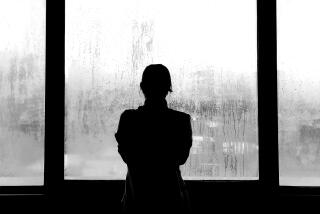Elaine Brody dies at 91; researcher put spotlight on issues of aging
Elaine M. Brody interviewed old people for admission to a Philadelphia nursing home, but the ones who especially worried her were the family members who brought them in.
They were, by and large, women in their middle years, the daughters and daughters-in-laws who were “overburdened and stressed” from long periods tending to elderly parents while also taking care of children and, increasingly, working outside the home.
Brody called them “women in the middle,” sandwiched between two generations that each relied on the women’s attention. This group would grow exponentially over the decades, causing a cascade of social issues that Brody was nearly alone in recognizing when she began her work in the late 1950s.
“There is a negative impact on the health and financial status of some of these women, but the most severe and pervasive effects,” she later wrote, “are emotional strains such as anxiety, depression, frustration, conflict, anger, feelings of guilt about not being able to ‘do it all,’ and stress from trying to do so.”
Brody, a social worker whose studies of older Americans and their caregivers helped to establish the field of gerontology, died July 9 of natural causes at her home in San Mateo, said her daughter, Laurel Ann Brody. At 91, Brody was, to use her own description, “very, very old.”
A prolific researcher during a career that spanned six decades, Brody wrote more than 200 academic papers and six books, including “Women in the Middle: Their Parent Care Years” (1990), which examined the trends, pressures and values causing crises in the lives of women caring for older family members.
When Brody began her studies, “older people in the public eye were seen as poor, sick … isolated social atoms,” said Barry D. Lebowitz, a professor of psychiatry at UC San Diego who for many years oversaw geriatric research at the National Institute of Mental Health.
“Elaine was really among the very first people to say, ‘No, no, no, that’s a cliche, a myth, a distortion,’ ” Lebowitz noted. “She said most older people are deeply embedded in the lives of families and the family is really the thing we ought to be talking about .… And when we talk about family, we mean the daughter.”
Although Brody recognized that some sons are caregivers, the case studies in “Women in the Middle” illuminated the problem.
“My two brothers and I are attorneys,” one of the women featured in the book told her. “When our mother, who lives in Florida, fractured a hip, everyone assumed that I would fly down and stay for a while. My brothers are good sons, but my suggestion that we take turns met with surprise. They said they had ‘to earn a living.’ And do you know something? I can’t figure out why, but I do it. I don’t know how long I can keep up this juggling act.”
Another misconception Brody exposed was “that adult children nowadays do not take care of their elderly parents as was the case in the good old days,” she wrote in a widely cited paper published in 1985.
She found that “families nowadays provide more care, more difficult care, and care over longer periods of time to more older people than was ever the case before,” she told the New York Times in 1985, when she was director of human services at the Philadelphia Geriatric Center, now known as the Abramson Center for Jewish Life.
Her book “Rape and Older Women,” co-authored with Linda J. Davis and published in 1979, was also groundbreaking in its examination of the scope and consequences of sexual assaults on women over 50.
Elaine Marjorie Breslow was born in New York City on Dec. 4, 1922. Her father, William J. Breslow, was a dentist, and her mother, Frieda Horowitz, was his bookkeeper. She graduated from City College of New York in 1942 and in 1943 married Stanley J. Brody, who became a noted expert in aging and public policy at the University of Pennsylvania.
When he was in the Navy during World War II, Stanley Brody encouraged his wife to apply to graduate school. She earned a master’s in social work from the University of Pittsburgh in 1945, but after her husband returned from the war she devoted herself to raising their two children.
In addition to her daughter Laurel Ann, she is survived by a son, Peter, four granddaughters and three great-grandchildren. Stanley Brody died in 1997.
In 1957, when her children reached school age, Brody took a part-time job doing intake interviews at the Philadelphia Geriatric Center, a home for the aged that had 150 beds, a morgue and not much in between.
She hesitated to take the job because her graduate training had focused on children, but she plunged in and, as she later observed, “I ended up working with parents and children as I had planned, though the parents were old and the children middle aged.”
She soon conducted her first research project, following up on the elderly applicants who were rejected because they were too debilitated. She found that some had died while others were living with stressed-out families or in boarding houses where they were neglected.
The center’s management gradually loosened its policies to admit older people with more impairments. It also created a research unit, now called the Polisher Research Institute, where Brody became associate director. As the center evolved, it became a model of comprehensive care and services for older adults.
Brody spent 31 years at the center, retiring in 1988. She later moved to Phoenix and San Diego before relocating recently to San Mateo to be near her son.
One of her contributions at the Philadelphia center was establishing a group residence for senior women who needed some assistance but not full-time care. That living arrangement “sounds so typical and ordinary to us now,” Lebowitz said, “but in those days, the early 1970s, this was considered revolutionary.”
Brody, who was named one of Ms. magazine’s “Women of the Year” in 1986, often spoke about taking care of her own mother — a strong-minded woman who once refused a doctor’s prescription for Valium because it meant she wouldn’t be able to worry. She lived to be 99.
Although Brody spent much of her life studying other people’s reactions to aging, she was unsettled by the realization that she was no longer the observer but the subject.
“I do not remember becoming old,” she told a gathering of the Gerontological Society of America in 2009, when she was 86. “All of a sudden, I was there. Others perceive me as old. Cars stop to let me cross. People offer to help carry my packages.”
So when a granddaughter asked if she was happy, she struggled for an answer until the young woman reframed the question: “Are you glad to be alive?”
“I was able to answer that question at once,” Brody said in the speech, titled “On Being Very, Very Old: An Insider’s Perspective.”
“Yes! I am glad to be alive today.”
Twitter: @ewooLATimes
More to Read
Start your day right
Sign up for Essential California for the L.A. Times biggest news, features and recommendations in your inbox six days a week.
You may occasionally receive promotional content from the Los Angeles Times.







